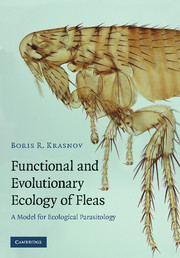Book contents
- Frontmatter
- Contents
- Preface
- Part I Brief descriptive ecology: what do fleas do?
- Part II Functional ecology: how do fleas do what they do?
- Part III Evolutionary ecology: why do fleas do what they do?
- 14 Ecology and evolution of host specificity
- 15 Ecology of flea populations
- 16 Ecology of flea communities
- 17 Patterns of flea diversity
- 18 Fleas, hosts, habitats
- 19 What further efforts are needed?
- References
- Index
17 - Patterns of flea diversity
Published online by Cambridge University Press: 14 August 2009
- Frontmatter
- Contents
- Preface
- Part I Brief descriptive ecology: what do fleas do?
- Part II Functional ecology: how do fleas do what they do?
- Part III Evolutionary ecology: why do fleas do what they do?
- 14 Ecology and evolution of host specificity
- 15 Ecology of flea populations
- 16 Ecology of flea communities
- 17 Patterns of flea diversity
- 18 Fleas, hosts, habitats
- 19 What further efforts are needed?
- References
- Index
Summary
The search for patterns of biodiversity across locations and through time and the explanation of these patterns is one of the most popular themes in ecology. Understanding of biodiversity patterns in application to parasites is especially important because parasites play important roles in the regulation of populations and communities of their hosts (e.g. Combes, 2001; Poulin, 2007a) and because this understanding is crucial for successful control of diseases that hit humans as well as wild and domestic animals. In addition, parasites are living organisms and are de facto part of biodiversity. Moreover, parasitism is possibly more common than any other feeding strategy (Sukhdeo & Bansemir, 1996). Consequently, studying biodiversity patterns of parasitic organisms is also important from the point of view of conservation efforts because parasites deserve to be protected as much as any other living species (Windsor, 1990, 1995; Whiteman & Parker, 2005; Christe et al., 2006).
When a biodiversity study concerns parasites, at least one extremely important difference between parasites and free-living organisms should be taken into account. Any parasitic species is characterized by ‘dual location’. On the one hand, a ‘location’ for a parasite is the host species it exploits, whereas, on the other hand, it is the geographical location where a host (and, consequently, a parasite) occurs. It is well known that different host species harbour different number of parasite species (e.g. Caro et al., 1997).
Information
- Type
- Chapter
- Information
- Functional and Evolutionary Ecology of FleasA Model for Ecological Parasitology, pp. 410 - 435Publisher: Cambridge University PressPrint publication year: 2008
